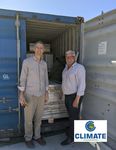Welcome & Update from our Climate Foundation Team! - Tasmania
←
→
Page content transcription
If your browser does not render page correctly, please read the page content below
Newsletter 1/2021
Welcome & Update from our Climate
Foundation Team!
Oh what a challenging year 2020 was for us! It started with Brian in Australia for a Tasmanian site visit
followed by speaking at the 2019 Christmas Woodford Folk Festival. In early 2020 we deployed at our
field location in the Philippines. In March, we gave an invited lecture on marine carbon drawdown using
seaweed forests, at the Plant Carbon DrawDown Symposium at the Salk Institute in San Diego. Upon
our return to the Western Pacific, Coronavirus
was starting to make headlines, so we
relocated to Singapore while supporting the
core team in the Philippines - and that was
just the first few months! The year went on to
include boat repairs, funding delays, logistical
challenges and revisions to partner plans. Oy!
Fortunately, this year we had the help of
superheros, including MinterEllison, who
worked tirelessly to help us establish
Australian Distinguished Talent visas amidst a
pandemic. We also had great support from
good people like Hatch and the 2040 team.
The hard work paid off and the adventure
continues in Queensland, Australia, where we
have set up headquarters. During these
developments, wonderful things keep happening; People from around the world have been reaching out
and helping us. Take a quick look below at the latest updates, and know that the whole Climate
Foundation team is working to help our beloved planet regenerate life in the ocean.
Wishing you a wonderful new year,
Brian and Rebecca
Updates - Tasmania
You might remember the breeding program from our second newsletter? The baby kelp was grown from
spores collected from the existing giant kelp off of
the Tasmanian coast and then planted onto test
lines. With your help, Climate Foundation
supported UTAS, who established one group of
giant kelp near commercial salmon pens and
another group in the same area, but away from
the salmon pens. It’s been a year, so we asked
UTAS to check on the results. And guess what?
The kelp grown away from the salmon pens
grew 2.5 meters, and the kelp grown near the
salmon pens grew a whopping 10 meters in thesame time span! Our theory about seaweeds needing nutrients is validated. (Note: kelps and other seaweeds are not plants even though they photosynthesise – they are algae which is a group clearly differentiated from plants). Photo - left: Our tiny baby giant Kelps were planted last year at the Huon Aquaculture Storm Bay Salmon Lease as part of the collaborative project between Climate Foundation, IMAS, and Huon Aquaculture. Photo credit: Cayne Layton. As for techniques - the restoration sites that used seeded twine had limited success. Fortunately, a second method was tried out at the same time which used small (50 x 50 mm) plates seeded with micro-kelp - and they did a great job of surviving. We also funded UTAS to start a “seed bank” as a result of a newly developed cold storage technique that enables long term storage of the microscopic stages of the giant kelp. In more collaboration, hatchery processes were developed that will help to expand the scope and scale of the work to save the giant kelp. Another project success includes identifying family lines of giant kelp that are tolerant of warm water. Thanks again for your help. Because of you, CF has supported the Institute for Marine and Antarctic Studies (IMAS) in its efforts to develop methods of natural kelp restoration. If we all work together, we can make a difference. Photo right: The giant kelp flourishing at the end of 2020. Credit: Cayne Layton, Institute for Marine and Antarctic Studies, University of Tasmania Philippines More good news! The Philippines team successfully irrigated red seaweeds with upwelled water on a deepwater Marine Permaculture platform more than 300 meters deep. Even with Covid-19 going on, our team of heros secured permits as an essential agricultural service, which allowed them to continue working during the lock-down. They didn’t stop there - and went on to secure permits from the Filipino Navy, the coast guard, the local barangay and fisheries commissions. Photo - right: Team member July Gadia triumphantly standing on one of our builds during lockdown. Photo Credit: Pepe Tubal
Because the Philippine lockdown impacted our ability to get
supplies/parts for creating the platforms, we did what we do best.
Photo left- Team member Alejandro Conde, improves the paint. Photo
Credit: Eric Smith
It all paid off. All this hard work resulted in the two-trough experiment, which we deployed in over 1000
feet ( 304 meters) deep water - which proved that seaweed really does need cool, nutrient rich water to
thrive!
Check out the photo below by Eric Smith - the thick, dark seaweed was in the trough in the upwelled
water and the scraggly light colored seaweed was in the ocean temperature water. (When you think about
it, the outcome is profound considering the need for survival for the rest of the warming oceans.) The test
seaweed had over twice the mass of the control seaweeds after the same month-long growing period.
AND all of our new findings and advancements are being
shared with our global team. The Marine Permaculture
development program, which we hope will enable progress
with a MP deployment from Australia all across the Pacific.
All which proves the adage - “ Where there is a will, there is
a way.”
In addition, we are doing seaweed product testing for food,
feed and fertilizer applications. Depending on the results
(we are pretty confident it will turn out well) then we can
start production, and give more locals jobs, and help
seaweed farmers and fishermen succeed.
2021 Plans
Because of our great results, we put kelp into cold storage for access by future
Cooperative Research Centre (CRC) projects. AND, in 2021 we plan to
propose a project to the Blue Economy Cooperative Research Center
(BECRC), to see if we can advance our work to save the dying kelp in Eastern
Tasmania (and obtain a sustainable yield along the way to interest more
people growing kelp offshore.)These BECRC plans are in collaboration with CSIRO, IMAS, UTAS, Huon Aquaculture, the Australian
Maritime College, and the Tasmanian Department of Primary Industries, Parks, Water & Environment
focussed on trialing methods to restore kelp beds on natural reefs.
Coming up: A three way, ten-month wave-driven upwelling pump design collaboration. CF is
coordinating with AMC and Hatch including students and faculty at the UTAS Australian Maritime
college (AMC).
Hatch is helping us refine the engineering of platforms to be tested from the Philippines to
South East Asia, Australia and the South Pacific. Great things are happening!
In the News
According to scientists, we only have two to twelve years before climate disruption really starts getting
out of control. If ever you were to take action - this next decade is the time. This article is alarming, but
we know how to slow things down, and possibly reverse global warming. So the sooner we can raise
funding together for the larger scale Marine Permacultures, the sooner we can make a difference, the
sooner we can change the course of the planet!
Sir David King, former chief scientific adviser to the British government,
emeritus professor and the founding chair of the Center for Climate Repair
at the University of Cambridge,acknowledged that Marine Permaculture
just may be the most promising and most cost effective drawdown
methodology on the planet. You can see the original article here and
because there is a paywall, a synopsis is here
Edmund Hillary Fellowship -
While we were working in Singapore, Dr. Brian Von Herzen
applied for the Edmund Hillary Fellowship in New Zealand. Much
to our delight- he was accepted in 2020 as an Edmund Hillary
Fellow. This created good connections and opened up New
Zealand and other big ocean nations as a possible country for
future Marine Permaculture deployment and Climate Foundation projects. See here.How You are Helping
Are you familiar with Dr Bronners? Emanuel Bronner started making
his ecological soaps in 1948 that are now certified organic and fair
trade."Being ahead of their time and earth conscious, we were thrilled
and flattered when Dr Bronners walked the talk and contributed
$10,000 last year! A big thank you goes out to them for their generosity
and support. We love it when companies work at doing good for
everyone on this planet.
SUNNY DONATION
Many Perth homeowners that installed Solar PV system prior to July 2011 received an extra
40c per kWh feed-in Tariff. Solar was expensive back then and most people installed 1.5 to 3kW
systems. Now after 10 years, the 40c feed-in
tariff is finishing and Western Australians have
been updating their systems to larger 6.6kW
systems with a view to installing a battery.
Generally these old Solar Panels are still in pretty
good condition but the installation doesn’t comply
with the new electrical safety standards and
although these systems have well and truly paid
for themselves. Craig Donohue,(father of our
amazing Sam Donohue, working with us in the
Philippines), owns a solar panel company called
Clean NRG Solar in Perth.When Clean NRG
replaces solar panels, they ask their customers if
they would like to help people out in the
Philippines rather than see their old panels go to
landfill. And of course, every time, they would
rather help. So Clean NRG Solar is collecting an
entire container of solar panels to ship over to the
Climate Foundation team in the Philippines, to
power Marine Permacultures for the locals. We
love it when people in the community give back - it’s helping our environment do good.
Photo- above: Brian Von Herzen and Craig Donohue, CEO of Clean NRG Solar, stand in front of the container of donated solar
panels. Photo credit: Rebecca TrumanPOWER OF GIVING Thanks to one of our supporters, the Climate Foundation has been added to the PSEG Power of Giving Program. This listing makes the Climate Foundation eligible to receive matching gifts from PSEG. You can also ask your employer if they would be willing to match your donations to the Climate Foundation - so every dollar you give is turned into two! Your donations keep us going, and we appreciate it - cause we also want this planet to survive. Here at the Climate Foundation, we work to protect the vulnerable and those without a voice. As a result, we tend to be a pushover for abandoned cuties in the Philippines, this little one shown on the right is the latest rescue. Photo credit: Eric Smith *Rosie Note: Happy New Year and Welcome to our new subscribers. I want to add a salute to Brian and Rebecca. Helping to write the newsletter has given me the opportunity to follow their year closer than most. Thanks to their tireless efforts, the Climate Foundation and its wonderful work has flourished in the most trying of times. And thank you again for your input, support, and signing up to help in the way that is best for you. Because of you, we are making wonderful progress - which the Earth needs to survive!
You can also read



























































